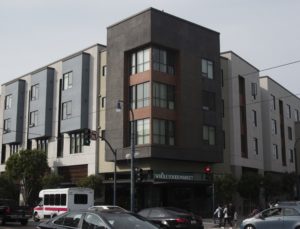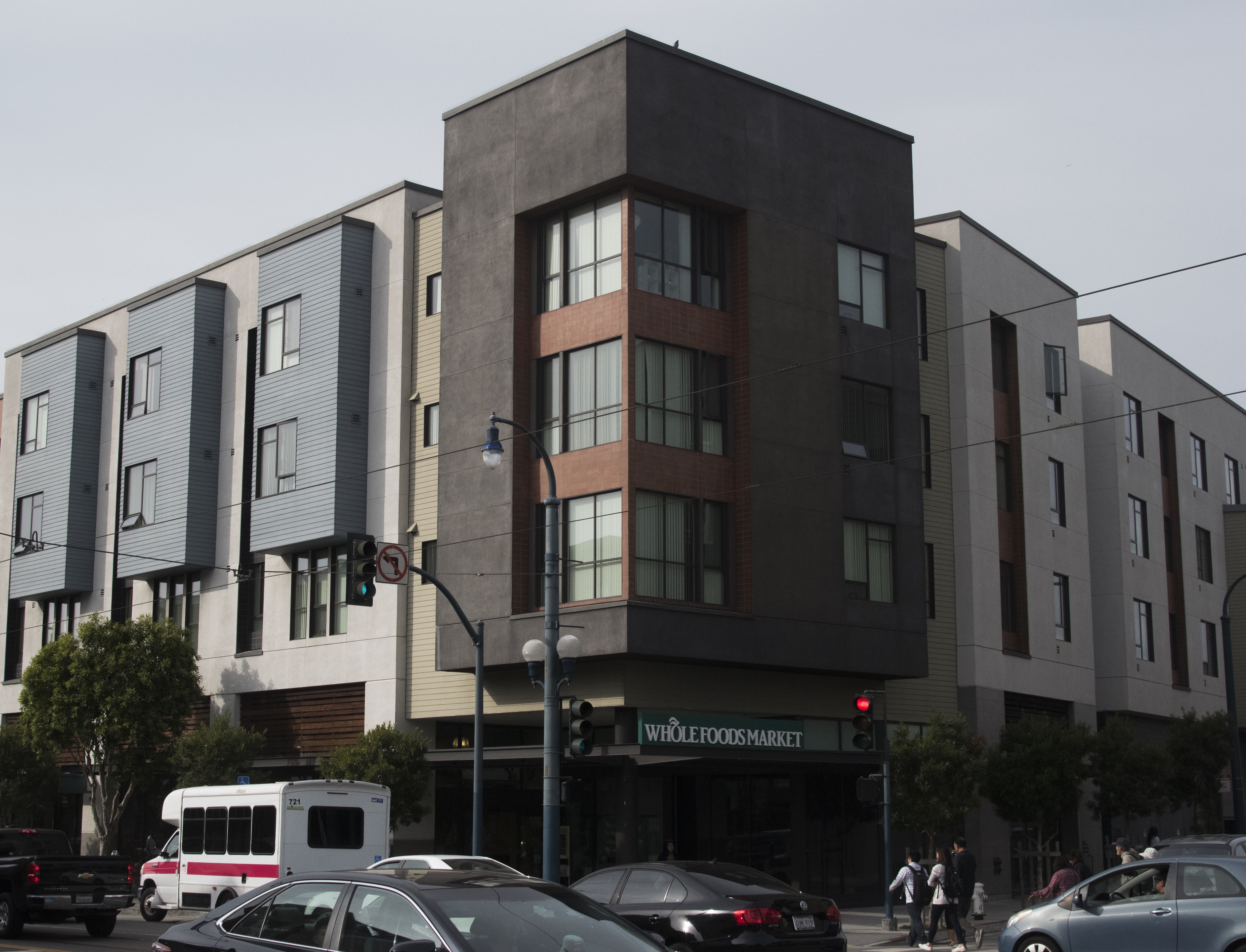Every evening after school, I drive down twenty-five blocks of Ocean Avenue on my way home. I pass Whole Foods, Phillz, Poke Bowl, and the new park on the north side of the street. On the south side, I see the gas station, a handful of liquor stores, Beep’s, McDonald’s. Already there are conflicting atmospheres. As I continue northwest on Ocean Avenue, I spot some older businesses that have so far managed to stick around, and long blocks of local restaurants. Ocean Avenue, the center of the Ingleside neighborhood, has been able to retain some of its history. Even so, the neighborhood is in the process of gentrifying.
A baseline definition for gentrification: the process of renovating and improving a house or district so that it conforms to middle-class taste.
One new construction project at 1601 Ocean will turn a section of small businesses into a new mixed-use complex, displacing numerous local stores and shops. In a number of years, the units will be finished, allowing newer, more expensive stores to move in. While the project will make space for more businesses to open on Ocean Avenue, it will also eliminate existing ones. The closure of these local shops will likely have a negative impact on the community of neighbors that have been here a long time, forcing them to travel longer distances to find affordable real estate.
that have been here a long time, forcing them to travel longer distances to find affordable real estate.
Another new apartment complex is at 1490 Ocean. Two- and three-bedroom apartments are going for approximately $1.1 million each. The price is quite high for a neighborhood, and is a clear example of gentrification.
The gentrification of Ocean Avenue picked up steam with the 2012 opening of Whole Foods and the adjoining apartments. Joel Roos (Will Roos ‘19), a San Francisco real estate developer for 28 years, offers perspective. He says, “the development of the Avalon Bay/Whole Foods Market was a big turning point for Ocean Avenue. The mom and pop grocery stores can no longer survive, and the car and body shops are no longer seen as providing ‘value’ to the neighborhood.”
In 2010, the Whole Foods company agreed to sign onto the Avalon Bay project already underway, with assurance that there would be a community of people to grocery shop at their store. With the increasing number of upscale businesses comes residents of a higher socio-economic status. It really is a cycle that just keeps going, though, as these businesses only want to come to the neighborhood if there is a population wealthy enough to shop or eat there. The addition of a grocery store has obvious benefits for a community, like not having to travel to get groceries. In this case, however, Whole Foods is a pricier store that cannot accommodate many of the residents that were already living on Ocean Avenue.
There is still one affordable housing option on Ocean Avenue, however. Unlike other developments on the street, Mercy Housing is designed for residents who earn less than 50% of the median income for the area, which is approximately $47,382 for nonfamily households, and $74,988 for family households. Mercy Housing California is a non-profit which strives to make it possible for San Franciscans with lower incomes to live and thrive in their communities. According to an article published in 2013 by the official San Francisco Office of the Mayor website, funding for the development came from tax credits, investments, and loans provided by the city, non-profits, and local banks.
The Ingleside neighborhood is just one example of ongoing gentrification in San Francisco. Entrepreneurs and high-salaried workers from Silicon Valley, for example, are moving into the city. They are looking for for an urban and upscale place to live. Small businesses and lower and middle income families throughout the city have been forced out.
Even as home prices soar throughout San Francisco, some locals think that economic changes haven’t hit the Ingleside community as drastically as some other areas. Oleg Osipoff, who has taught visual arts at Lick-Wilmerding for 36 years, says, “I think the neighborhood has been fairly consistent compared to other parts of the city. It is still a working class and middle class area.” Within that economic constant, he comments that different waves of people have come to live in the Ingleside neighborhood, explaining that now there “are a lot of immigrants.” He adds, “It used to be much more of a black neighborhood and now it is much more Asian and Pacific Islander.” Recent statistics show that 56% of the people living in the Ingleside neighborhood are Asian, with the African-American population at 12%.
As the neighborhood becomes wealthier, newer businesses are making attempts to beautify Ocean Avenue’s physical landscape. Mr. Osipoff mentions the efforts by “Whole Foods and various other businesses, that are making the neighborhood look more attractive.” There is a new little plaza on the corner by the fire station, with a climbing structure for kids, and tables to sit and eat at. In addition, the recently cleared grassy area at the intersection of Ocean and Geneva is one of several aesthetic improvements. The Ingleside area isn’t considered to be a particularly trendy or “posh” neighborhood, Mr. Osipoff states, but “Ocean Avenue is the center of growth for the neighborhood.”
Just how much growth?
“The Ocean corridor is under-developed and will be developed much like what we see in other commercial corridors such as Mission, Street, Third Street, and Irving Street,” say Roos. “It’s unfortunate, but the city will, in my opinion, become even more homogenized than it is, as a result of the gentrification.”
And then what? Roos stresses the need to include affordable units in new housing projects, like the one he is building on nearby Balboa Reservoir. “It will be important for the teachers, firefighters, police, retail employees, etc. to reside in the city,” he explains.
The thing about neighborhoods is that they are always evolving, and as is often the case, there is both bad change and good change. Ocean Avenue is a perfect example. Gentrification continues to severely impact the community and the people who live in it. On the other hand, this wouldn’t be the vibrant, diverse community it is today without significant change that began more than half a century ago. Back then the upscale Ingleside Terrace neighborhood near Ocean Avenue had racial covenants, which typically banned people of color and Jews from living there. Says Roos, “Obviously, the neighborhoods that surround Ocean Avenue are now multicultural.” In this instance, at least, change has definitely been good. The neighborhood, although pricey, remains a vibrant, diverse community.






